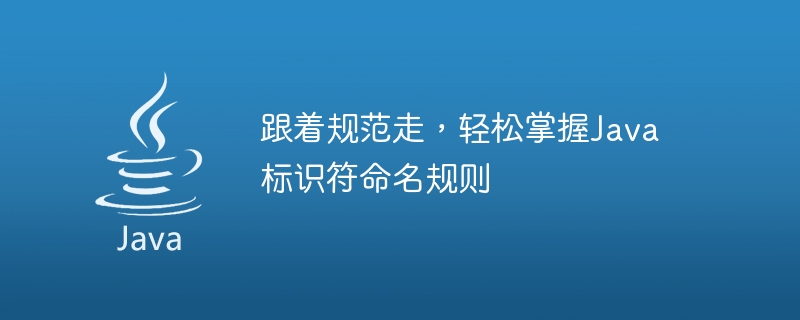

Java identifier naming rules: clear and easy to read, standardized and unified
In Java programming, identifiers are used to name variables and methods , class and package symbols. The choice of identifiers is critical to the readability and maintainability of your code. Following Java identifier naming rules can help you write clear, readable, standardized and unified code.
1. Identifiers consist of letters, numbers, underscores, and dollar signs
Java identifiers can consist of letters, numbers, underscores, and dollar signs. Among them, letters can be uppercase or lowercase, and numbers cannot be used as the first character of the identifier. For example, the following are valid identifiers:
name age _age $age
2. The identifier cannot be a Java keyword
Java keywords are words with special meanings in the Java language , cannot be used as an identifier. For example, the following are Java keywords:
abstract boolean byte case catch char class const continue default do double else extends final finally float for if implements import instanceof int interface long native new null package private protected public return short static super switch synchronized this throw throws transient try void volatile while
3. Identifiers cannot begin with numbers
Identifiers cannot begin with numbers. For example, the following identifiers are invalid:
1age 2name 3_age
4. The identifier cannot contain spaces
The identifier cannot contain spaces. For example, the following identifiers are invalid:
name age age_name
5. The identifier cannot be the same as a Java reserved word
Java reserved words are words reserved in the Java language , cannot be used as an identifier. For example, the following are Java reserved words:
abstract assert boolean break byte case catch char class const continue default do double else enum extends final finally float for goto if implements import instanceof int interface long native new package private protected public return short static strictfp super switch synchronized this throw throws transient try void volatile while
6. Identifiers should be descriptive
Identifiers should be descriptive so that other programmers can easily understand them its meaning. For example, the following identifiers are descriptive:
customerName productName orderDate
7. Avoid abbreviations for identifiers
Abbreviations for identifiers should be avoided because abbreviations may Making the code difficult to understand. For example, the following identifiers are difficult to understand:
custName prodName ordDate
8. Identifiers should avoid using underscores
Identifiers should avoid using underscores because underscores may cause The code is difficult to read. For example, the following identifiers are difficult to read:
_customer_name _product_name _order_date
9. Identifiers should follow camelCase
Identifiers should follow camelCase, i.e. each The first letter of a word is capitalized and the remaining letters are lowercase. For example, the following identifiers follow camel case:
customerName productName orderDate
10. Identifiers should follow a consistent naming style
Identifiers should follow a consistent naming style , so that other programmers can easily understand the code. For example, you can use the following naming style:
##Hungarian nomenclature: The variable name prefix indicates the type of the variable, for example:
Pascal nomenclature: The variable name consists of words, each Capitalize the first letter of each word, for example:
CamelCase nomenclature: The variable name is composed of words, the first letter of the first word is lowercase, and the first letter of the remaining words is uppercase, for example:
Code example:
public class Customer {
private String customerName;
private String customerAddress;
private String customerPhoneNumber;
public Customer(String customerName, String customerAddress, String customerPhoneNumber) {
this.customerName = customerName;
this.customerAddress = customerAddress;
this.customerPhoneNumber = customerPhoneNumber;
}
public String getCustomerName() {
return customerName;
}
public void setCustomerName(String customerName) {
this.customerName = customerName;
}
public String getCustomerAddress() {
return customerAddress;
}
public void setCustomerAddress(String customerAddress) {
this.customerAddress = customerAddress;
}
public String getCustomerPhoneNumber() {
return customerPhoneNumber;
}
public void setCustomerPhoneNumber(String customerPhoneNumber) {
this.customerPhoneNumber = customerPhoneNumber;
}
}The above is the detailed content of Master Java identifier naming rules and follow the specifications with ease. For more information, please follow other related articles on the PHP Chinese website!
 What should I do if English letters appear when I turn on the computer and the computer cannot be turned on?
What should I do if English letters appear when I turn on the computer and the computer cannot be turned on?
 What to do if the login token is invalid
What to do if the login token is invalid
 Why webstorm cannot run the file
Why webstorm cannot run the file
 What is the difference between USB-C and TYPE-C
What is the difference between USB-C and TYPE-C
 How to open vsd file
How to open vsd file
 oracle clear table data
oracle clear table data
 What is the working principle and process of mybatis
What is the working principle and process of mybatis
 How to use Swagger
How to use Swagger




